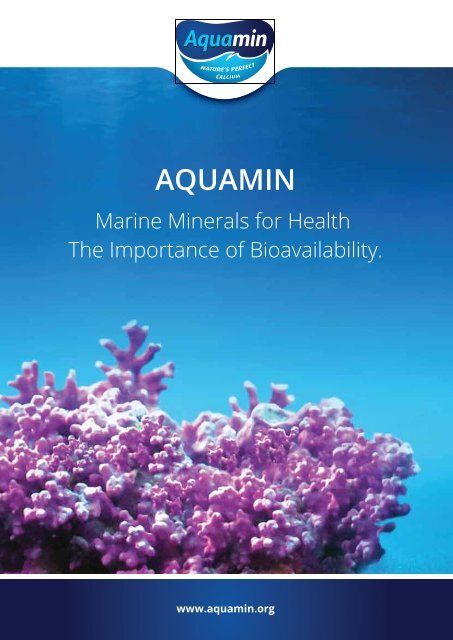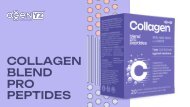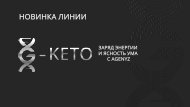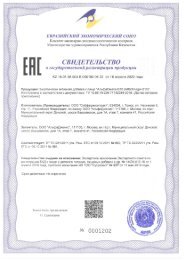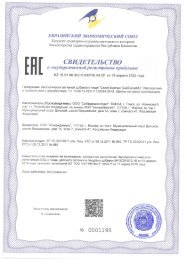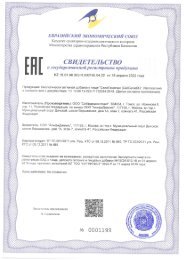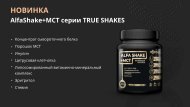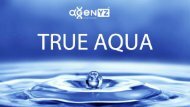Aquamin Bioavailability
You also want an ePaper? Increase the reach of your titles
YUMPU automatically turns print PDFs into web optimized ePapers that Google loves.
AQUAMIN<br />
Marine Minerals for Health<br />
The Importance of <strong>Bioavailability</strong>.<br />
www.aquamin.org
<strong>Aquamin</strong><br />
The Importance of <strong>Bioavailability</strong><br />
Dr. Denise O’Gorman, B.Sc., Ph.D.<br />
What is <strong>Aquamin</strong><br />
<strong>Aquamin</strong> is a natural, marine-derived, multi- mineral, from<br />
the Lithothamnion species of red algae, rich in calcium and<br />
magnesium as well as 72 other trace minerals. It is crafted<br />
naturally in the sea, providing bioavailable minerals in the<br />
same ratios as needed for optimal use by the human body.<br />
The structure of <strong>Aquamin</strong> is also unique. It is highly porous<br />
in nature maximising absorption and bioavailability.<br />
It is well accepted that calcium bioavailability is influenced<br />
and enhanced by the presence of other minerals.<br />
At Marigot Ltd, we have carried out many studies to prove<br />
the bioavailability of <strong>Aquamin</strong> over that of other calcium<br />
sources, especially those mined from rocks. These studies<br />
exploit the known sensitivity of serum parathyroid<br />
hormone (PTH) to calcium levels. Insufficient levels of<br />
calcium in the body trigger PTH to release calcium from<br />
bone, stimulating bone breakdown. Therefore, lowering<br />
PTH levels over both the short and long-term is a dual<br />
indicator of the bioavailability of calcium and of bone<br />
protection<br />
<strong>Bioavailability</strong><br />
Study 1<br />
This double-blind, placebo-controlled, cross-over study2<br />
measured the bioavailability of <strong>Aquamin</strong> versus calcium<br />
carbonate (CaCO 3 ) and placebo over 6 hours in 12<br />
pre-menopausal women. The results were dramatic, after<br />
just 60 minutes, the ability of <strong>Aquamin</strong> to reduce the levels<br />
of PTH significantly exceeded that of CaCO 3 and this trend<br />
continued for the duration of the study, Figure below.<br />
PERCENT CHANGE IN SERUM PTH<br />
15 30 60 90 120 180 240 300 360<br />
0<br />
-5<br />
-10<br />
-15<br />
-20<br />
-25<br />
-30<br />
-35<br />
AQUAMIN F CALCIUM CARBONATE PLACEBO<br />
Study 2<br />
A second longer-term, double-blind, placebo-controlled,<br />
parallel-group study lasting 3 months was also carried out.<br />
Sixty post- menopausal women were randomised to<br />
<strong>Aquamin</strong>, CaCO 3 , Tri-calcium phosphate (TCP) or placebo<br />
groups and PTH levels were recorded. After 3 months, PTH<br />
levels had significantly decreased in subjects taking<br />
<strong>Aquamin</strong>.<br />
1 Saltman & Strause (1992) J. Am. Coll. Nutr. 12(4):384-9<br />
2 Minnesota Applied Research Centre, USA (unpublished)<br />
3 Shandon Clinic, Cork, Ireland (unpublished)<br />
4 Slevin et al., Under review 2013.<br />
5 Aslam et al., (2013) Biol Trace Elem Res: In Press<br />
6<br />
7<br />
8<br />
9<br />
10<br />
O’Gorman et al., (2012) Phyto. Res. 26(3):375-80<br />
Widaa et al., Phytotherapy Res (2013) In press<br />
Barry et al., (2011) Med & Sci in Sports & Exer 43(4):617-23<br />
Aslam et al., (2010) Calcif Tissue Intl 86(4):313-24<br />
Lee et al., (2010) J Exp Biomed Sci, 16(4):213-20
<strong>Aquamin</strong><br />
The Importance of <strong>Bioavailability</strong><br />
Dr. Denise O’Gorman, B.Sc., Ph.D.<br />
Effect of Calcium Supplement on Serum PTH<br />
Difference after 3 month period<br />
changes were also seen in the bone markers, osteocalcin<br />
(figure below) and CTX, in both treatment groups.<br />
0.20<br />
0.00<br />
-0.20<br />
-0.40<br />
-0.60<br />
-0.80<br />
-1.00<br />
AQUAMIN<br />
CALCIUM CARBONATE<br />
TCP<br />
PLACEBO<br />
Bone Osteoporosis is a ‘silent’ disease striking one in three<br />
women and one in five men globally. It is however, a<br />
preventable disease, if we start building strong bones at an<br />
early enough age. While calcium is considered to be the<br />
most important mineral in bone, several other minerals<br />
also play a major role1. A calcium only supplement ignores<br />
the complete mineral profile essential for healthy bones.<br />
0<br />
-0.5<br />
-1<br />
-1.5<br />
-2<br />
-2.5<br />
25<br />
20<br />
Lumbar spine<br />
(L1-L4)<br />
*<br />
PLACBO<br />
AQUAMIN TM Femural<br />
AQUAMIN<br />
Total body<br />
and NUTRAFLORA<br />
TM<br />
*<br />
*<br />
*<br />
*<br />
Study 3 Human Clinical Trial<br />
15<br />
This recent study highlighted the benefits of <strong>Aquamin</strong> in<br />
10<br />
post- menopausal women. 300 women were randomised<br />
5<br />
to 3 groups, placebo, <strong>Aquamin</strong> or <strong>Aquamin</strong> and scFOS<br />
(short-chain fruto- oligosaccharides) for a period of 2<br />
years. The results are compelling and are currently under<br />
review. Not only did DEXA scans confirm bone protection<br />
in the combined <strong>Aquamin</strong> & scFOS group (Figure below)<br />
0<br />
Placcbo<br />
BASELINE<br />
12 MONTHS<br />
Aqaumin TM<br />
Aqaumin TM and<br />
NutraFlora*<br />
24 MONTHS<br />
but significant beneficial<br />
1 Saltman & Strause (1992) J. Am. Coll. Nutr. 12(4):384-9<br />
2 Minnesota Applied Research Centre, USA (unpublished)<br />
3 Shandon Clinic, Cork, Ireland (unpublished)<br />
4 Slevin et al., Under review 2013.<br />
5 Aslam et al., (2013) Biol Trace Elem Res: In Press<br />
6<br />
7<br />
8<br />
9<br />
10<br />
O’Gorman et al., (2012) Phyto. Res. 26(3):375-80<br />
Widaa et al., Phytotherapy Res (2013) In press<br />
Barry et al., (2011) Med & Sci in Sports & Exer 43(4):617-23<br />
Aslam et al., (2010) Calcif Tissue Intl 86(4):313-24<br />
Lee et al., (2010) J Exp Biomed Sci, 16(4):213-20
<strong>Aquamin</strong><br />
The Importance of <strong>Bioavailability</strong><br />
Dr. Denise O’Gorman, B.Sc., Ph.D.<br />
Study 4 <strong>Aquamin</strong> reverses the bone<br />
damaging effects of a High Fat Western Style<br />
Diet (HFWD).<br />
Poor diets, especially those containing a high proportion of<br />
fat, or those lacking in essential minerals have been<br />
identified as risk factors for osteoporosis. This study<br />
highlights the benefits of <strong>Aquamin</strong> when added to both<br />
control and high fat animal diets5. Bones from the HFWD<br />
diet show deformity and fragility at the end of the 18<br />
month dietary modification compared to those diets<br />
supplemented with <strong>Aquamin</strong> (figure below)<br />
AIN76A<br />
AIN76A+<br />
Suppl.<br />
HFWD<br />
HFWD+<br />
Suppl.<br />
When the long bones from all the mice in each group were<br />
pooled a numerical increase in the amount of calcium,<br />
magnesium and potassium was seen with <strong>Aquamin</strong><br />
supplementation. The most significant increase was seen<br />
in the levels of strontium following supplementation with<br />
<strong>Aquamin</strong>. Strontium is used in many pharmaceutical drugs<br />
to protect from bone deterioration and fragility.<br />
Calcium<br />
Strontium<br />
Calcium (µg/g)<br />
250000<br />
200000<br />
150000<br />
100000<br />
50000<br />
Strontium (µg/g)<br />
300<br />
200<br />
100<br />
0<br />
0<br />
MALE<br />
5 12 18<br />
Magnesium<br />
5 12 18<br />
Potassium<br />
4000<br />
1500<br />
FEMALE<br />
Magnesium (µg/g)<br />
3000<br />
2000<br />
1000<br />
Potassium (µg/g)<br />
1000<br />
500<br />
0<br />
0<br />
The trabecular bone also shows significant deterioration in<br />
the absence of <strong>Aquamin</strong> (not shown) echoing the results in<br />
study 9.<br />
5 12 18<br />
xxxx<br />
xxxx<br />
HFWD<br />
HFWD + xxxx<br />
5 12 18<br />
1 Saltman & Strause (1992) J. Am. Coll. Nutr. 12(4):384-9<br />
2 Minnesota Applied Research Centre, USA (unpublished)<br />
3 Shandon Clinic, Cork, Ireland (unpublished)<br />
4 Slevin et al., Under review 2013.<br />
5 Aslam et al., (2013) Biol Trace Elem Res: In Press<br />
6<br />
7<br />
8<br />
9<br />
10<br />
O’Gorman et al., (2012) Phyto. Res. 26(3):375-80<br />
Widaa et al., Phytotherapy Res (2013) In press<br />
Barry et al., (2011) Med & Sci in Sports & Exer 43(4):617-23<br />
Aslam et al., (2010) Calcif Tissue Intl 86(4):313-24<br />
Lee et al., (2010) J Exp Biomed Sci, 16(4):213-20
<strong>Aquamin</strong><br />
The Importance of <strong>Bioavailability</strong><br />
Dr. Denise O’Gorman, B.Sc., Ph.D.<br />
Study 5 <strong>Aquamin</strong> actively promotes<br />
mineralisation of bone cells.<br />
This publication proves that <strong>Aquamin</strong> with its rich supply<br />
of minerals directly benefits osteoblasts, the building<br />
blocks of bone. This study confirms that the bioavailable<br />
minerals, magnesium, manganese, barium, strontium and<br />
iron as well as calcium are needed for optimum bone<br />
formation.<br />
Murine osteoblasts cells were grown in optimal tissue<br />
culture media for 28 days. Incredibly when <strong>Aquamin</strong> was<br />
added mineralisation of these cells increased threefold.<br />
Study 6 A more recent study showed that<br />
these beneficial effects on bone were further<br />
enhanced in the presence of Vitamin D.<br />
Alkaline Phosphase Expression<br />
Normallised to Cell Number<br />
4.0E-07<br />
3.0E-07<br />
2.0E-07<br />
1.0E-07<br />
*<br />
**<br />
***<br />
x<br />
0.0E+00<br />
x<br />
Osteogenic<br />
Control<br />
Osteogenic Control+<br />
Vitamin D (5nM)<br />
<strong>Aquamin</strong> <strong>Aquamin</strong> +<br />
Vitamin D (5nM)<br />
x<br />
(*P
<strong>Aquamin</strong><br />
The Importance of <strong>Bioavailability</strong><br />
Dr. Denise O’Gorman, B.Sc., Ph.D.<br />
<strong>Aquamin</strong>-containing sports drinks taken either before or at<br />
4 intervals during the time trial or a placebo. Figure below.<br />
HFWD & <strong>Aquamin</strong> diet, again indicating the superiority of<br />
highly bioavailable calcium and the value of a natural<br />
multi-mineral mix.<br />
100<br />
*<br />
**<br />
80<br />
AIN76A HFWD Supplemented<br />
HFWD<br />
Change in PTH (pg/mL)<br />
60<br />
40<br />
20<br />
0<br />
Placebo Ca Before Ca during<br />
Trabecular Cortical<br />
Study 8 <strong>Aquamin</strong> reverses the bone<br />
damaging effects of a High Fat Western Style<br />
Diet (HFWD).<br />
In this 15 month study, an earlier version of Study 4<br />
highlighting the detrimental effects of a poor diet on bone,<br />
mice were fed either a) control ‘chow’ or b) a HFWD or c) a<br />
HFWD & <strong>Aquamin</strong>. Female mice on the HFWD showed<br />
significant bone deterioration compared to control mice<br />
while mice on the HFWD & <strong>Aquamin</strong> diet showed improvements<br />
in bone structure. Interestingly, the control group<br />
containing CaCO 3 had an equivalent calcium level to the<br />
<strong>Aquamin</strong> prevents the harmful effects of a HFWD as<br />
shown in both the outer cortical and inner trabecular<br />
‘spongy’ bone. AIN76A is the control ‘chow’ diet<br />
containing CaCO 3 .<br />
Study 9 <strong>Aquamin</strong> F combines with probiotics<br />
to protect against bone loss.<br />
Probiotics enhance mineral absorption from the intestine.<br />
This study proves that the combination of <strong>Aquamin</strong> and<br />
probiotics can improve bone health over probiotics alone.<br />
1 Saltman & Strause (1992) J. Am. Coll. Nutr. 12(4):384-9<br />
2 Minnesota Applied Research Centre, USA (unpublished)<br />
3 Shandon Clinic, Cork, Ireland (unpublished)<br />
4 Slevin et al., Under review 2013.<br />
5 Aslam et al., (2013) Biol Trace Elem Res: In Press<br />
6<br />
7<br />
8<br />
9<br />
10<br />
O’Gorman et al., (2012) Phyto. Res. 26(3):375-80<br />
Widaa et al., Phytotherapy Res (2013) In press<br />
Barry et al., (2011) Med & Sci in Sports & Exer 43(4):617-23<br />
Aslam et al., (2010) Calcif Tissue Intl 86(4):313-24<br />
Lee et al., (2010) J Exp Biomed Sci, 16(4):213-20
<strong>Aquamin</strong><br />
The Importance of <strong>Bioavailability</strong><br />
Dr. Denise O’Gorman, B.Sc., Ph.D.<br />
The rat OVX osteoporosis model closely represents the<br />
human menopause. Adult rats have their ovaries removed<br />
and quickly develop many of the negative symptoms of<br />
menopause including rapid bone loss.<br />
A B C<br />
Study 10 <strong>Bioavailability</strong> of calcium in-vitro<br />
This study was carried out by Professor Nora O’Brien at<br />
University College Cork in Ireland. For these experiments, a<br />
plant-based (<strong>Aquamin</strong>) and a rockbased mineral source<br />
(Dolomite) were compared by subjecting samples to<br />
in-vitro digestion and subsequent analysis by AAS. The<br />
respective magnesium and calcium levels are graphed<br />
below.<br />
For both calcium and magnesium, <strong>Aquamin</strong> shows twice<br />
the level of bioavailability as dolomite.<br />
D E F<br />
Ca recovery as% initial conc.<br />
80<br />
70<br />
60<br />
50<br />
40<br />
30<br />
20<br />
10<br />
0<br />
<strong>Aquamin</strong><br />
Dolomite W<br />
The femur bone in A) is a control bone where ovaries are<br />
intact. In B) the intact animals were fed a calcium<br />
deficient diet. In C) the animals had their ovaries<br />
removed (OVX) and were fed a normal diet. The diets<br />
were then supplemented with D) probiotics E) <strong>Aquamin</strong><br />
or F) probiotics and <strong>Aquamin</strong>.<br />
These results show that <strong>Aquamin</strong> alone (E) prevents<br />
deterioration of bone and this is further improved on the<br />
addition of probiotics L paracasei, L rhamnosus and S<br />
thermophillus (F).<br />
Mg recovery as% initial conc.<br />
Figure 1 Percent calcium recovery from supplements digested at<br />
a concentration of 2.0 mg calcium/mL digestate. Each bar represents three<br />
individual experiments ± SE.<br />
70<br />
60<br />
50<br />
40<br />
30<br />
20<br />
10<br />
0<br />
<strong>Aquamin</strong><br />
Dolomite W<br />
Figure 2 Percent magnesium recovery from supplements digested at<br />
a concentration of 2.0 mg magnesium/mL digestate. Each bar represents<br />
three individual experiments ± SE.<br />
1 Saltman & Strause (1992) J. Am. Coll. Nutr. 12(4):384-9<br />
2 Minnesota Applied Research Centre, USA (unpublished)<br />
3 Shandon Clinic, Cork, Ireland (unpublished)<br />
4 Slevin et al., Under review 2013.<br />
5 Aslam et al., (2013) Biol Trace Elem Res: In Press<br />
6<br />
7<br />
8<br />
9<br />
10<br />
O’Gorman et al., (2012) Phyto. Res. 26(3):375-80<br />
Widaa et al., Phytotherapy Res (2013) In press<br />
Barry et al., (2011) Med & Sci in Sports & Exer 43(4):617-23<br />
Aslam et al., (2010) Calcif Tissue Intl 86(4):313-24<br />
Lee et al., (2010) J Exp Biomed Sci, 16(4):213-20
AQUAMIN<br />
MARINE MINERALS FOR HEALTH<br />
TM<br />
WHAT IS AQUAMIN:<br />
A unique marine multi-mineral complex providing bioactive<br />
calcium, magnesium and 72 other trace minerals.


